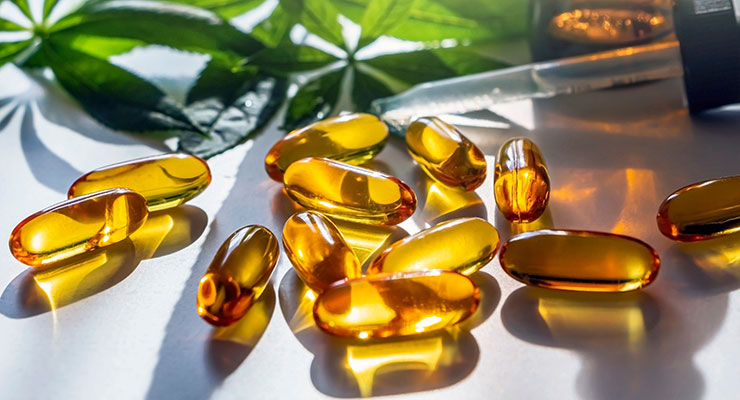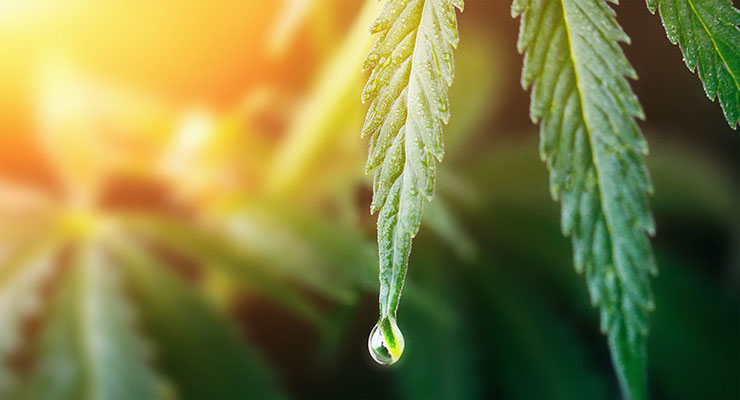Features
Hemp and CBD Updates: Industry Still in the Weeds
Where do standards and regulations stand, and how are brands navigating shaky terrain?

By: Mike Montemarano

At Natural Products Expo West in Anaheim, CA this past March, experts discussed the latest developments on all fronts of the burgeoning hemp, cannabis, and CBD industries.
Though industrial hemp and CBD products have been on the market for several years since the passage of the 2018 Farm Bill, the category for ingestible products as a whole is still in its nascent stages.
The legal status of products containing CBD remains about as murky as it did upon the passage of legislation which legalized the production of industrial hemp containing no more than 0.3% THC. While it seems increasingly less likely that the U.S. Food and Drug Administration (FDA) will provide a pathway to market for CBD to be used as a dietary ingredient any time soon, states are passing their own legislation, leaving a patchwork of regulations across the U.S. Meanwhile, there is inconsistency across the industry when it comes to quality, testing standards, labeling, marketing, and overall terminology.
Advancing the Science
The regulatory status surrounding cannabis and CBD products has slowed clinical research on specific health benefits, and FDA has largely targeted companies making disease claims.
The setting and promotion of standards in science, analytical testing, terminology, and more will be an important foundational effort to set the groundwork for when legal change facilitates large-scale investigations into the benefits of hemp and cannabis products, according to Holly Johnson, PhD, chief science officer for the American Herbal Products Association (AHPA).
“There is a lot of good effort to advance science and standards around hemp and cannabis,” Johnson said. “AOAC International, which used to be a part of the USDA, has been very important as a standard-setting organization in terms of analytical methods for compliance … They stepped up after the Farm Bill passed to help create hemp determination standards. So, labs are receiving freshly-cut hemp from the field to do compliance testing, and needed guidance there to figure out how to handle this new botanical material showing up at their door. AOAC developed a cannabis analytical sciences program, setting standards for contaminants, cannabinoid levels, and more of the quality-type tests that you’d need for hemp. They are doing product specific standards, with beverages being really important—obviously, you’d test those differently than a hemp flower.”
Meanwhile, USP is publishing a manuscript in the Journal of Natural Products along with an accompanying active pharmaceutical ingredient monograph for CBD.
AHPA’s Hemp Lexicon document reflects another important undertaking: translating botanical terminology for researchers, marketers, and policymakers to have consistent, standardized language.
The Regulatory Front
The FDA recently reasserted its position in its response to two New Dietary Ingredient (NDI) notifications that CBD should be excluded as a dietary ingredient based on drug preclusion provisions of the Dietary Supplement Health and Education Act (DSHEA) of 1994.
“FDA was incredibly disingenuous with those NDIs, and they used work that the companies conducted on ensuring consistency against them,” said Steve Mister, president and CEO of the Council for Responsible Nutrition (CRN). “In meetings leading up to NDI submissions, the companies knew an awful lot about how to grow it, going all the way back to the seed. When the response letters were issued, FDA raised objections on the basis that the product was the same article as (the approved pharmaceutical) Epidiolex. They said ‘you know so much about CBD, you must be selling it—whether it is full- or broad-spectrum—you must be selling CBD, and that is the article that’s in Epidiolex.’ So, they said, ‘you know too much,’ and used it against them.”
The drug preclusion provision is a “race to market paradigm,” Mister noted, meaning CBD was studied and sold as a drug before it had an established profile as a safe dietary ingredient. However, “this was not a fair race. This ingredient was a controlled substance for all those years. It’s like a race where one person’s shoes were tied together, and that should make a difference. The normal race-to-market paradigm shouldn’t apply in this case.”
Another way to get out of the legal bind, Mister said, is to note the clear difference between a broad-spectrum hemp product containing CBD and CBD isolate in its pharmaceutical form. “Maybe it’s not the same ‘article,’” Mister said. “What the industry is selling, doses of 10 or 20 mg of CBD, is not the same as the daily dose sold in Epidiolex, which is 1,500 mg. If it’s sold in a matrix as a broad spectrum product, maybe that’s not the same as a pure isolate. But FDA refused to make that distinction.”
“If it doesn’t get around this drug provision, we can’t even begin to discuss the safety considerations,” Mister continued. CRN is very concerned about how much authority will be given to FDA regarding safe dosage determinations. “CRN is pretty adamant that the (2018 Farm Bill) doesn’t give FDA the authority (to determine safe daily intake levels), and that’s important even if they are more likely to approve of CBD as a dietary ingredient if they have authority over those dosage levels. Think about dietary supplements on a general level; FDA doesn’t have the ability to set a safe premarket level upfront. Giving FDA too much authority here as a way for one ingredient to get to market is a dangerous precedent for the supplements industry.”
What FDA may rule to be a safe level of CBD for market access “would be so conservative that the industry couldn’t live with it,” Mister said, noting he doubts the agency would be flexible if evidence supported the safety of dosages greater than anything they set in the moment.

Be Prepared
It’s imperative that all players in the hemp and CBD space proactively check all marks for establishing CBD as a dietary ingredient, said Rend Al-Mondhiry, partner at Amin Talati Wasserman. “The issue here is not just with CBD; the drug industry is looking at all of the cannabinoids in hemp, including CBN, CBG, and THCV, which are all being illegally marketed as dietary supplements … We’re encouraging all of our clients to get their safety and toxicology data to be prepared for legalization. What makes it difficult is that FDA doesn’t enforce its own NDI provisions, but it’s still the law and you need some safety basis before you put something into a dietary supplement. And only a handful of companies have that data now.”
Al-Mondhiry noted that the Farm Bill’s 0.3% THC by dry weight limit applies to industrial hemp only—not to finished products. This means that companies will need to prepare for unexpected turns of events regarding the THC concentration limits in their products, and many states are in the beginning process of imposing their own finished product limits in the absence of national standards.
“But there’s not enough research yet on the mind-altering effects of these low dosages,” she said. Further, “Oregon and other states are looking to ban artificially-derived cannabinoids, so stuff that’s not from a natural extraction process may be on the chopping block in many states. But what do we call these extracts—synthetic or artificially-derived? We need to standardize these definitions for state regulators.”
The Market Landscape
At a separate Expo West session on the evolution of cannabis, CBD, and hemp, experts discussed navigating the competitive consumer marketplace in 2022 and beyond.
“The CBD space is really exciting and nascent in its development,” said Sol Clahane, vice president and general manager, US Region, Canopy Growth, “and today’s consumer is looking to be proactive about overall health and wellness, but also mental health particularly. CBD is seen as a natural alternative to address a number of health conditions, and there is lots of innovation in product formats and ingredient combinations. But this is just one cannabinoid for now, and there is so much more potential in the plant.”
Marketing a supplement product in this category as health-promoting, without having the scientific background, can be challenging and requires a relatively safe strategy.
“The problem is the dicey legal area,” said Jonathan Small, editor-in-chief of Green Entrepreneur. “The CBD industry can’t receive grants to do extensive research. It’s the same problem that the cannabis industry faces with THC.”
CJ Rapp, CEO of Karma Water, said his company is taking the approach of “holistic health,” and for that reason, “we chose to work with a broad-spectrum extract. Our philosophy is wellness, a broad term which we think is an advantage. We can ebb and flow in marketing as the science unfolds, and figure out which ingredients can help a finished product to deliver on a particular promise.”
Establishing Trust
Responsible brands within this space, which has been described by many as a regulatory “Wild West,” are compelled to differentiate themselves from brands that are less transparent and don’t meet today’s early standards, which have little enforcement behind them.
“There is a real push now toward organic offerings, and natural is a big distinguishing claim among brands trying to differentiate themselves from the ‘gas station’ CBD,” said Small.
With few certifications available to finished product companies compared to those seen in the dietary supplements industry, marketing and brand partnerships based on educating consumers can be important credentials.
“People have a lot of questions about CBD, and brands are differentiating themselves by answering those questions and leaning toward consumer education,” Small said. “It’s a Wild West and I’m glad legitimate companies are in this space. People claim it cures everything, and that’s what’ll happen in the absence of regulation and oversight. I welcome the science and legitimate companies doing real research on products and third-party testing. People are excited but also skeptical and suspicious and know that it isn’t something that will cure everything.”
Clahane acknowledged there are bad actors in the market. “At Canopy we lean heavily on scientific backing and third-party testing, and we don’t bring products to market that aren’t ready. We formed a partnership with Martha Stewart based on educating people and a focus on health benefits. Retailers in other marketplaces have placed Martha Stewart products in their lineups, and this has elevated entire categories before. She’s a great recruiter and educator and has been innovative with the products developed under her brand.”
Canopy research suggests that “81% of CBD users recommend it to friends and family,” she continued. “So the best thing to do is educate more and more both at the point of purchase in retail and online.”
Rapp cautioned not to underestimate potential customers. “Information in long-format venues like digital can be helpful, and consumers will take the time to read it. It’s the responsibility of manufacturers to provide at least enough information for consumers to make an informed decision,” he said.
Even in the absence of regulatory oversight, brands can still benefit by working to establish trust through the traditional mechanisms seen in dietary supplements and other natural products, Small said.
“There might be an overreaction when CBD is approved as a legal dietary ingredient,” Rapp concurred. “Everyone wants to participate in this category, and there will be a big self-discovery process of which brands and products are authentic, and which are simply dipping their toes into the water with this market. It’s unknown which products will be the leaders, and I do worry about the period of time after FDA clears a path to market, because there will be a flood of new products. I think the cream will always rise, but the consumer and retailers can’t lose faith during that turbulent time period.”


